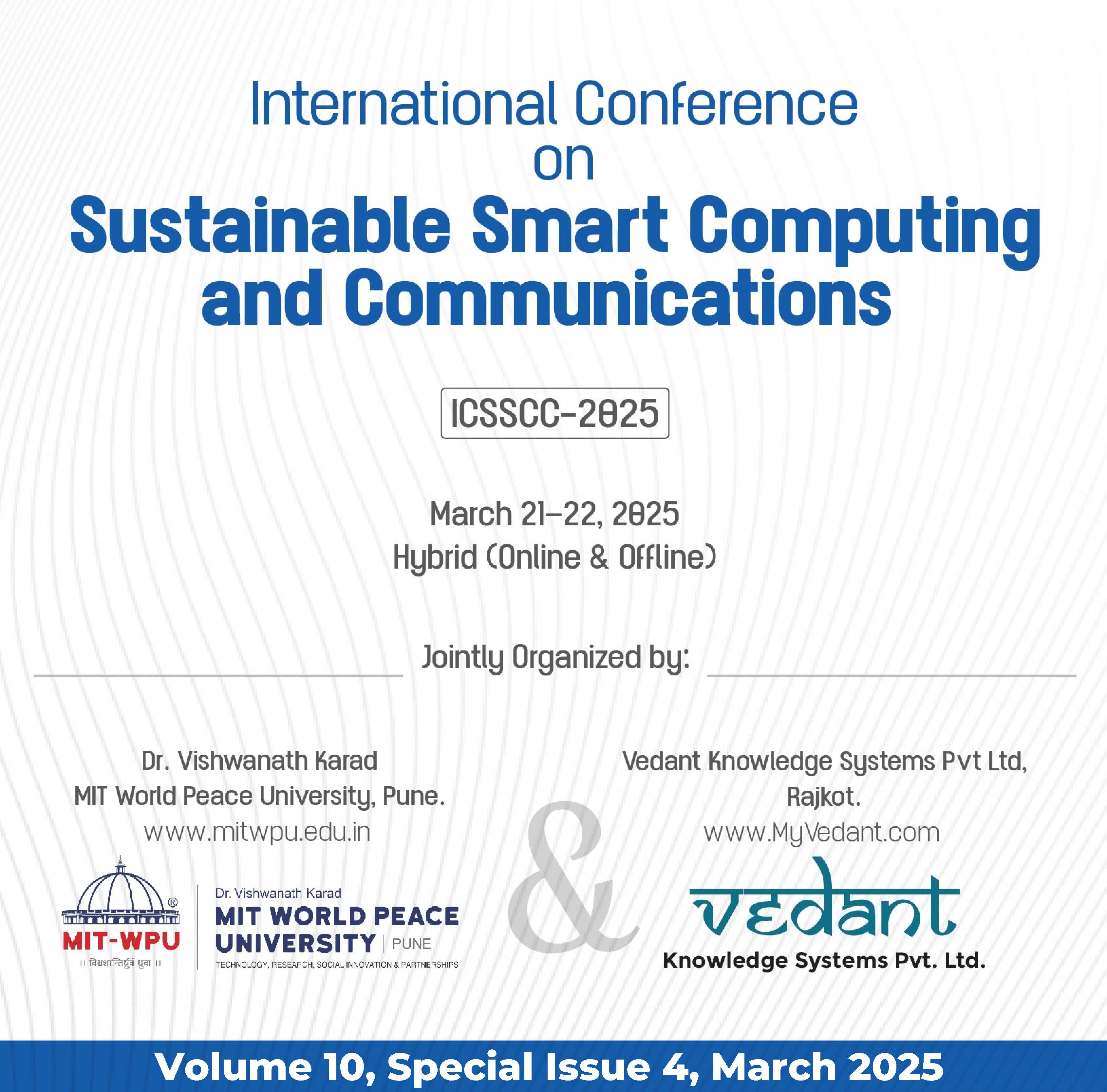Satellite-Based Water Volume Estimation: A Comprehensive Review of Remote Sensing & AI-Driven Approaches
Keywords:
Water Volume Estimation, Remote Sensing, Satellite Imagery, Hydrological Modelling, Data Fusion, AI, Machine Learning/Deep LearningAbstract
The estimation of the volume of water stored in natural and artificial water bodies is crucial for hydrological modelling, climate evaluation, and resource management. The conventional in-situ measurement methods and empirical models have spatial and temporal gaps, as well as high operational costs, which makes them inadequate for large-scale monitoring. The advancements made in satellite remote sensing, multi-modal data fusion, and computational intelligence have automated and made the estimation techniques more scalable, however, data occlusion, changes in sensor resolution, and complex hydrology present issues that need to address. This paper reviews the contemporary methodologies for the estimation of the water volume that include the optical and radar remote sensing, satellite altimetry, and AI based analytical frameworks. A systematic evaluation exposes the algorithmic solutions, dataset dependencies, and computational scalability highlighting key research gaps that require more flexible and agile responses. The advent of innovative paradigms such as deep learning, hybrid AI frameworks, and the integration of multi-source data presents substantial opportunities for improving predictive accuracy and adaptability. This study amalgamates established techniques with future prospects, thereby contributing to the advancement of automated, data-driven strategies for large-scale water volume estimation, ultimately improving hydrological forecasting and resource management.
Downloads
References
R. Ghanbari, “Using Optical Satellite Images And Satellite Altimetry Data To Estimate Volume Variations In Dams,” SSRN Electronic Journal, 2025, doi: https://doi.org/10.2139/ssrn.5138885.
J. Condeça, J. Nascimento, and N. Barreiras, “Monitoring the Storage Volume of Water Reservoirs Using Google Earth Engine,” Water Resources Research, vol. 58, no. 3, Feb. 2022, doi: https://doi.org/10.1029/2021wr030026.
Y. Lin et al., “Water Volume Variations Estimation and Analysis Using Multisource Satellite Data: A Case Study of Lake Victoria,” Remote Sensing, vol. 12, no. 18, p. 3052, Sep. 2020, doi: https://doi.org/10.3390/rs12183052.
J. Pimenta, J. N. Fernandes, and A. Azevedo, “Remote Sensing Tool for Reservoir Volume Estimation,” Remote Sensing, vol. 17, no. 4, pp. 619–619, Feb. 2025, doi: https://doi.org/10.3390/rs17040619.
Muhammad Usman, Lloyd H. C. Chua, Kim N. Irvine, Lihoun Teang, “Estimating water surface elevation for a wetland using integrated multi-sourced remote sensing data,” Springer Nature, doi.org/10.1007/s11273-025-10032-9
K.-H. Tseng et al., “Quantifying Freshwater Mass Balance in the Central Tibetan Plateau by Integrating Satellite Remote Sensing, Altimetry, and Gravimetry,” Remote Sensing, vol. 8, no. 6, pp. 441–441, May 2016, doi: https://doi.org/10.3390/rs8060441.
T. Bhagwat, I. Klein, J. Huth, and P. Leinenkugel, “Volumetric Analysis of Reservoirs in Drought-Prone Areas Using Remote Sensing Products,” Remote Sensing, vol. 11, no. 17, p. 1974, Aug. 2019, doi: https://doi.org/10.3390/rs11171974.
C. Liu et al., “Monitoring water level and volume changes of lakes and reservoirs in the Yellow River Basin using ICESat-2 laser altimetry and Google Earth Engine,” vol. 44, pp. 53–64, Jul. 2022, doi: https://doi.org/10.1016/j.jher.2022.07.005.
Y.-K. Lee, S.-H. Hong, and S.-W. Kim, “Monitoring of Water Level Change in a Dam from High-Resolution SAR Data,” Remote Sensing, vol. 13, no. 18, pp. 3641–3641, Sep. 2021, doi: https://doi.org/10.3390/rs13183641.
O. M. Sorkhabi, B. Shadmanfar, and E. Kiani, “Monitoring of dam reservoir storage with multiple satellite sensors and artificial intelligence,” Results in Engineering, vol. 16, p. 100542, Dec. 2022, doi: https://doi.org/10.1016/j.rineng.2022.100542.
Binh Pham-Duc et al., “Monitoring Lake Volume Variation from Space Using Satellite Observations: A Case Study in Thac Mo Reservoir (Vietnam),” Remote Sensing, vol. 14, no. 16, pp. 4023–4023, Aug. 2022, doi: https://doi.org/10.3390/rs14164023.
H. Gao, C. Birkett, and D. P. Lettenmaier, “Global monitoring of large reservoir storage from satellite remote sensing,” Water Resources Research, vol. 48, no. 9, Sep. 2012, doi: https://doi.org/10.1029/2012wr012063.
Z. Duan and W. G. M. Bastiaanssen, “Estimating water volume variations in lakes and reservoirs from four operational satellite altimetry databases and satellite imagery data,” Remote Sensing of Environment, vol. 134, pp. 403–416, Jul. 2013, doi: https://doi.org/10.1016/j.rse.2013.03.010.
M. L. Messager, B. Lehner, G. Grill, I. Nedeva, and O. Schmitt, “Estimating the volume and age of water stored in global lakes using a geo-statistical approach,” Nature Communications, vol. 7, no. 1, Dec. 2016, doi: https://doi.org/10.1038/ncomms13603.
A. Singh, F. Seitz, and C. Schwatke, “Application of Multi-Sensor Satellite Data to Observe Water Storage Variations,” IEEE Journal of Selected Topics in Applied Earth Observations and Remote Sensing, vol. 6, no. 3, pp. 1502–1508, Jun. 2013, doi: https://doi.org/10.1109/jstars.2013.2258326.
Arash Tayfehrostami, Abbas Abedini, and Bahman Tajfirooz, “Analyzing the variations in the water surface area of Taleqan Dam of Iran using ground-based and satellite observations,” pp. 1–4, Jan. 2023, doi: https://doi.org/10.1109/migars57353.2023.-10064509.
R. Abileah and S. Vignudelli, “A Completely Remote Sensing Approach To Monitoring Reservoirs Water Volume,” Jan. 2011.
W. Jiang et al., “Multilayer Perceptron Neural Network for Surface Water Extraction in Landsat 8 OLI Satellite Images,” Remote Sensing, vol. 10, no. 5, p. 755, May 2018, doi: https://doi.org/10.3390/rs10050755.
